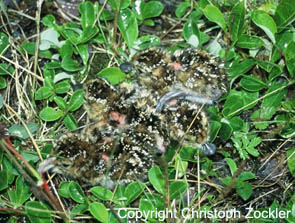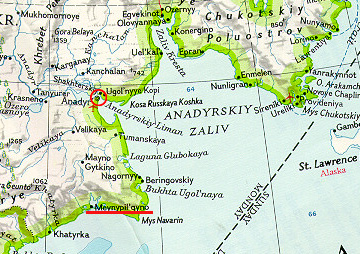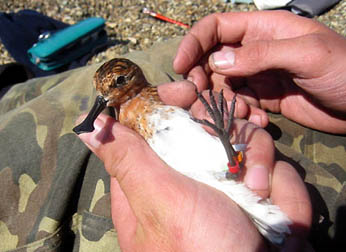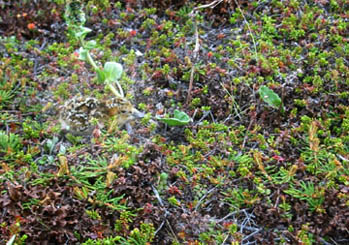Christoph Zöckler, September 2003

The following is a short summary report of this year’s expedition from the study area of Mainopylgino, Beringovski. Participants also included E. Lappo, V. Morozov, I. Taldenkov (all Moscow) and Minoru Kashiwagi from Tokyo. A full report will be produced later and published soon.
First main results:
There are more pairs breeding in South Chukotka than previously thought
Breeding in hilly habitats not only adjacent to the spit but up to 6 km from the sea has been found not to be an exception
There is additional evidence that the breeding success of the species is very low and threatening the population
Due to bad weather and logistical problems we arrived in the area only on June 12 (14 days later than anticipated!) However, fortunately the Spoonbilled Sandpipers were breeding surprisingly late this year (or in this area), about 6 – 10 days later than in last years study area in North Chukotka.

Mainopylgino is a broad gravel spit 50 km long and up to three km wide with ideal habitat conditions for Spoonbilled Sandpiper. It encloses the large Pikulny Lake with further suitable habitats along its western, and perhaps eastern, shores.
A team of 5, later 6, scientists covered the entire area by foot or motorcycle to reach more remote areas along the spit. Temporary camps at the outer ends of the spit allowed better access to the remotest areas.
Several hundred kilometres were walked and searched for Spoonbilled Sandpiper territories. In total 76 territories were identified by the end of July (map in prep). Some of the territories could not be confirmed on second visits, but by July 19th at least 38 nests or broods were found and not less than 60 pairs of Spoonbilled Sandpiper appear to breed in the area.
Surprisingly during a 12 day caterpillar excursion inland we found for the first time Spoonbilled Sandpiper breeding in adjacent hills. Two nests 30 km away from the majority of territories and 6 km distant from the sea or large lakes, at 62m and 68 m altitude, suggests that there might be additional pairs in the area.
The first complete nest was found on June 14, with a fairly fresh clutch not more than 2 or three days old. The brood hatched on July 4th with several others following the days after. The majority hatched on July 9 and 10, about 8 to 10 days later than in 2002 in Northern Chukotka.

During the expedition a total of 53 adult birds were caught, sexed, measured and individually colour-marked with a small green flag. Birds caught early in the season (29) also had feathers taken for further analyses on stable isotopes.
By July 11th 45 young birds have been ringed and colour marked in the same way.
By August about 85 young had been ringed.
At least 12 ringed chicks disappeared. In some cases broods already lost young before ringing. The number of predated or lost chicks is likely to be higher, but no exact figures could be gained, as the follow up of the families is very difficult. In Mainopylgino area the destiny of 50 – 60% of broods is unknown.
Considering normal and equal conditions as in North Chukotka in the 80s, it is reasonable to estimate fledgling success as approximately 2 chicks per brood. This survival rate value is based on 3-year studies by Tomkovich (1995), but there is reason to assume that it no longer applies: out of 31 birds ringed during a shorter visit in 2001 just one, the only adult out of the 31, has been re-sighted and found breeding again in the same area (only a few hundred meters from its ringing site). None of the ringed young (30) have yet returned or have been sighted, and it’s unlikely we would missed all of them. It is also unlikely that they hadn’t yet returned to the breeding grounds, as most Spoonbilled Sandpipers normally return in their second year, as was also proven in North Chukotka (Tomkovich 1994). (It is possible, but also not very likely, that the young had dispersed across a wider area and are now breeding further north.)
The hatching success rate is good with 87% hatched. Three nests were predated and two nests were abandoned for unknown reasons. The fledging success of the young has not been monitored for reasons mentioned above.
With now more than 200 colour-flagged birds in total it should be more likely that birds will be observed along migration routes. However of the 30 birds first ringed in 2000 only one recovery, from Japan, has been made, demonstrating both the difficulty of finding them and of the low observer density along the migration routes in question.
Several important questions remain unanswered: these include
the exact population size,
the main wintering area,
and the main reasons for the species decline.

With the stable isotope analyses of 29 feathers taken from the birds caught in the season in June/July 2003 we hope at least to be able to shed further light on the mystery of the wintering grounds. The analyses of O18 and Deuterium, promising geographical markers, alone will cost about 1,800 EUR, which is not yet fully funded. At present N and C isotopes, two more indicators pointing towards the wintering areas are being examined and results are due in a few weeks.
We’d like to thank the Research Commission of the DOG (German Ornithological Society) and the Keidanren Nature Conservation Fund (Japan) for generously supporting the expedition.
Christoph Zöckler
ArcCona Ecological Consulting
Cambridge, U.K.



